Tillandsia jucunda
Click thumbnails for full size, scaled to a new window.
Tillandsia jucunda
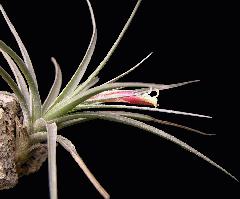
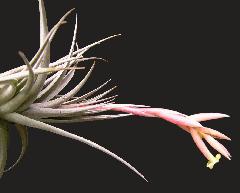
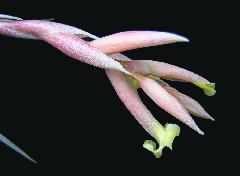
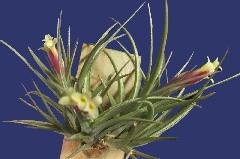
| Ken Woods 06/09 |
Ken Woods 03/10 |
Ian Hook 09/05 (possibly 'Aussie Gold') |
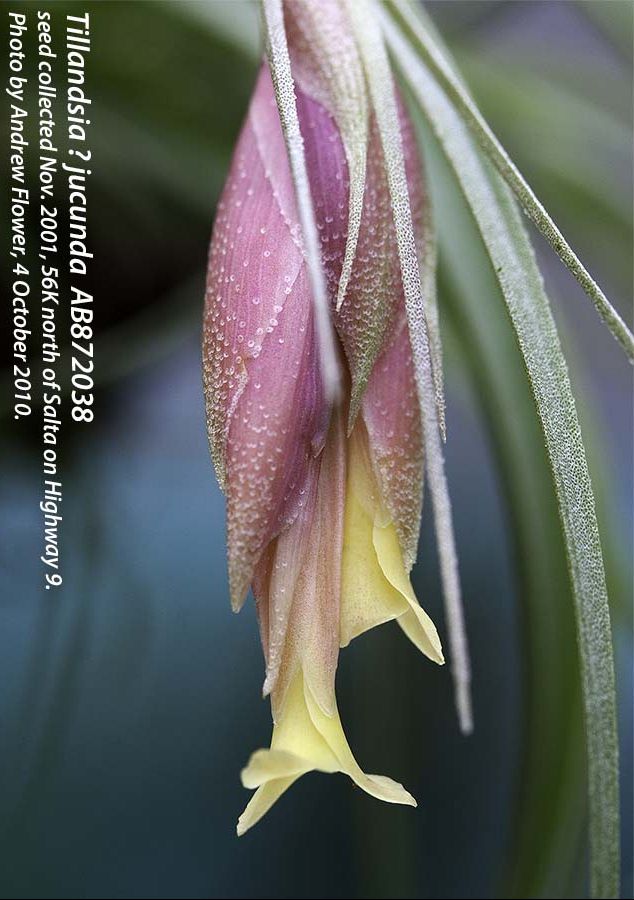
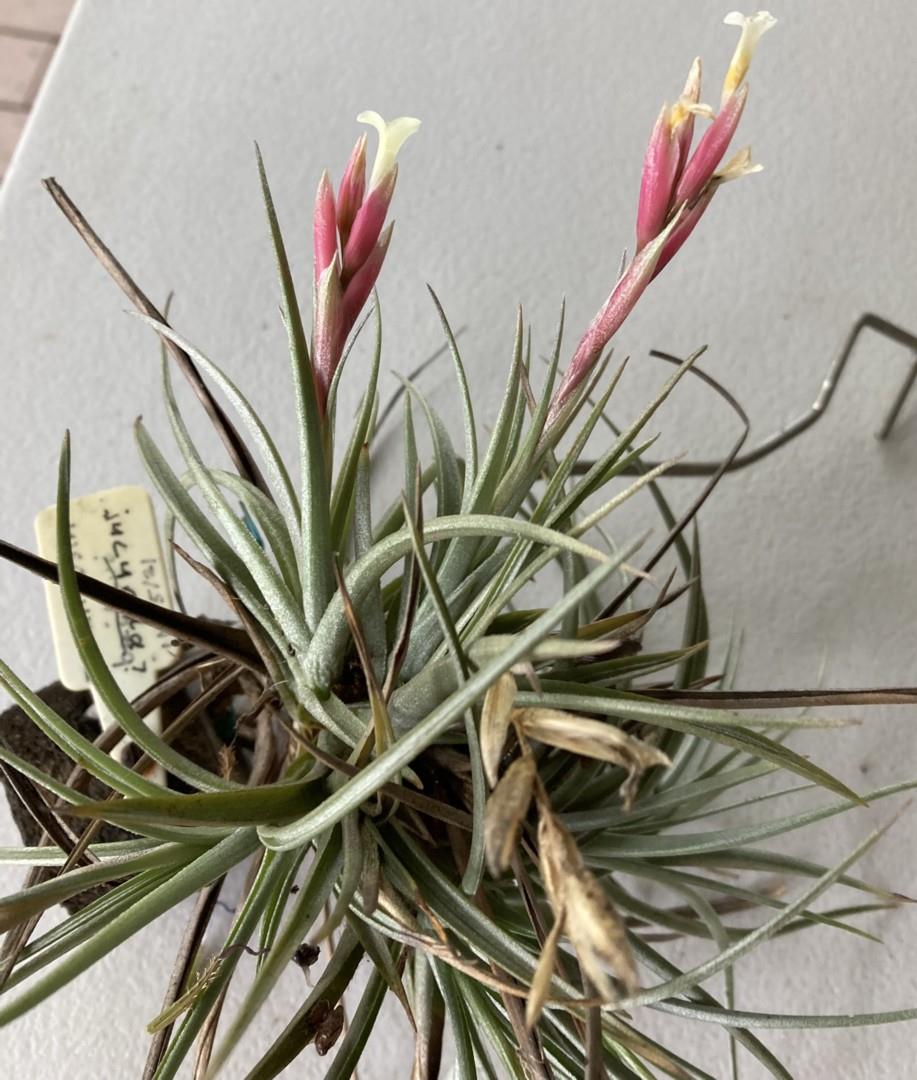
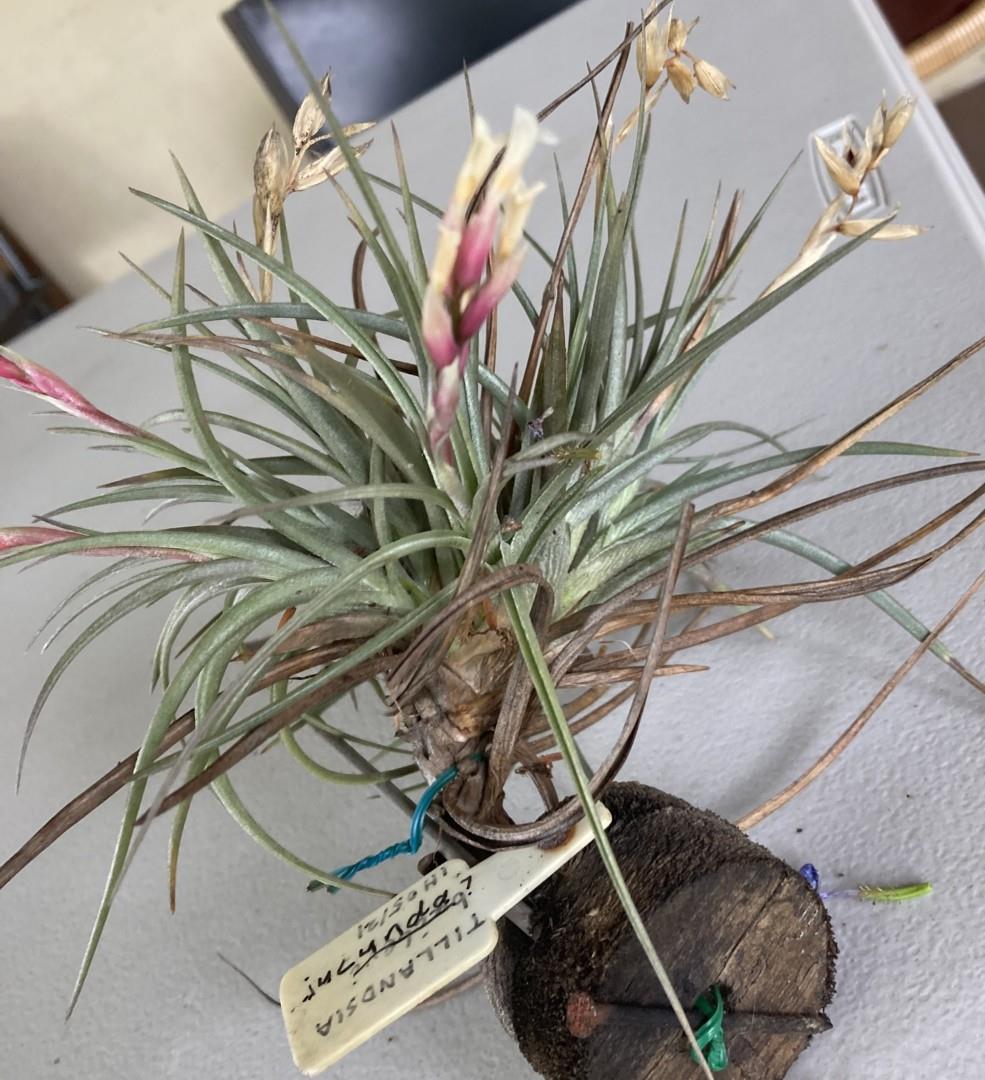
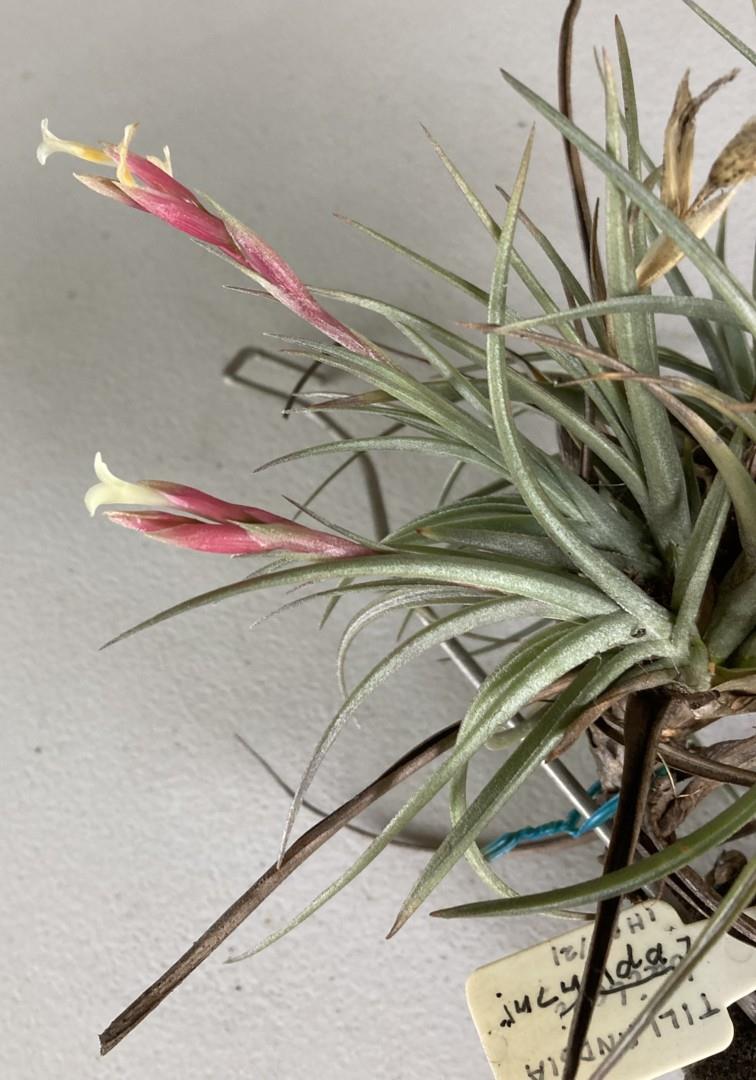
| Andrew Flower 09/15 (See T. Aussie Gold notes) |
Ian Hook 01/24 |
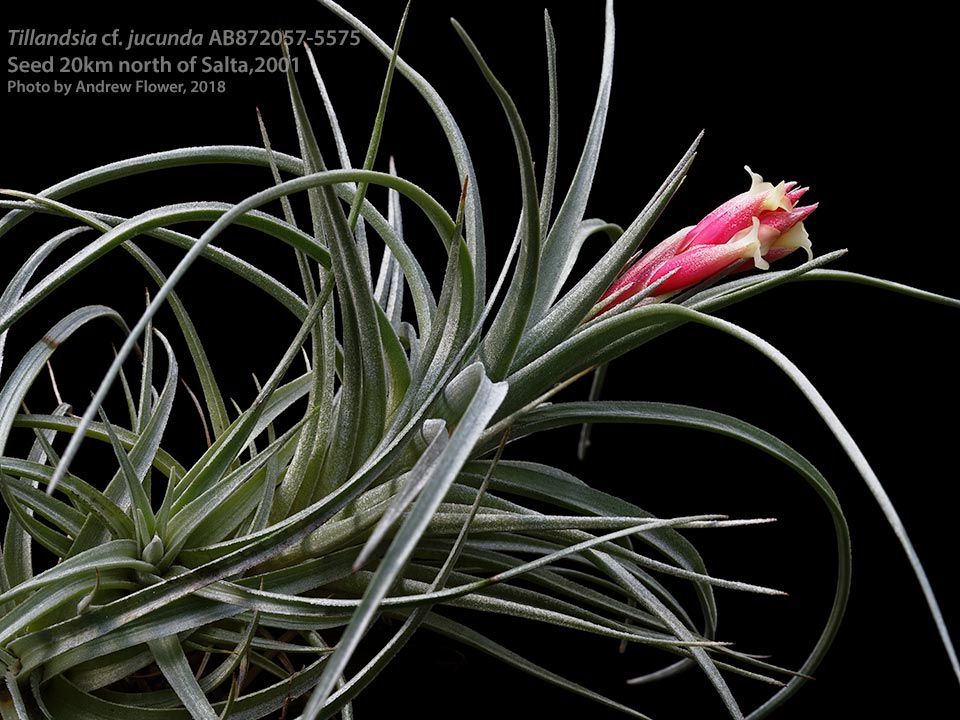
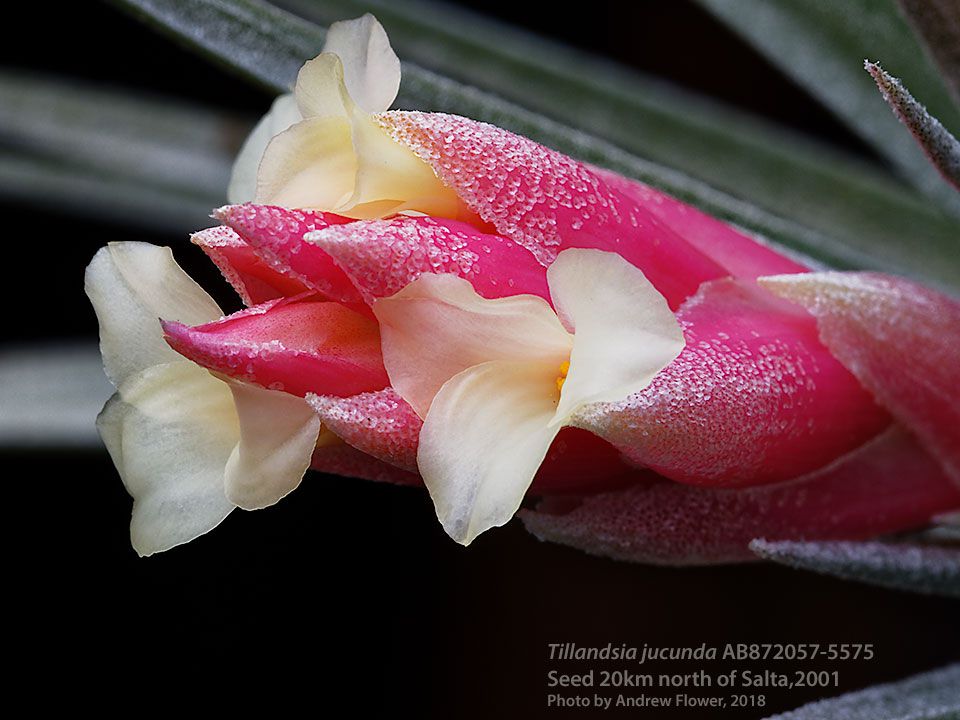
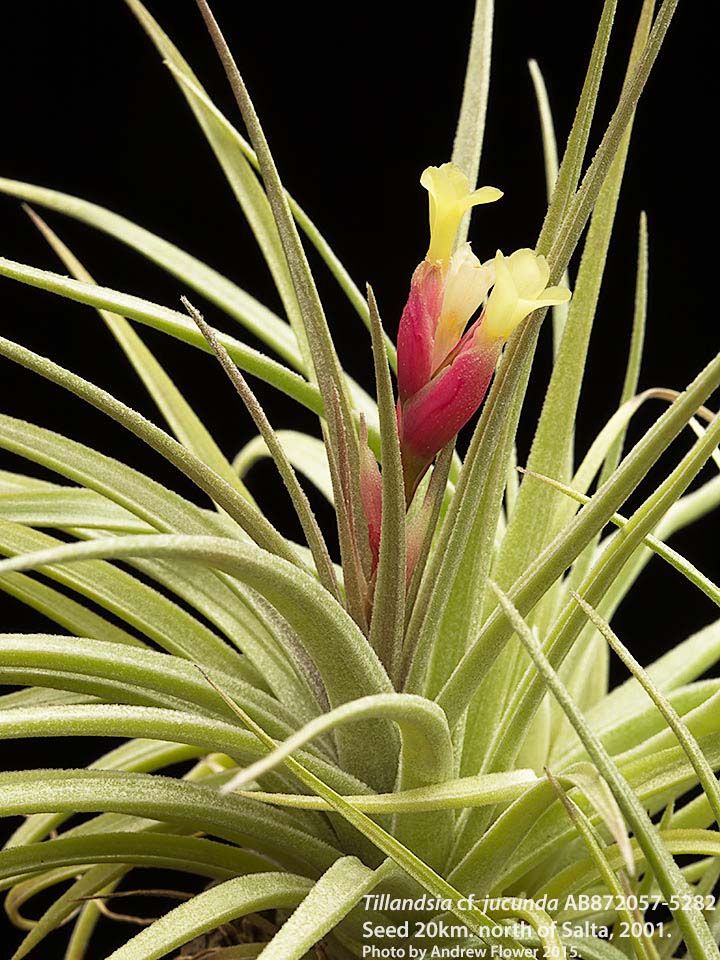
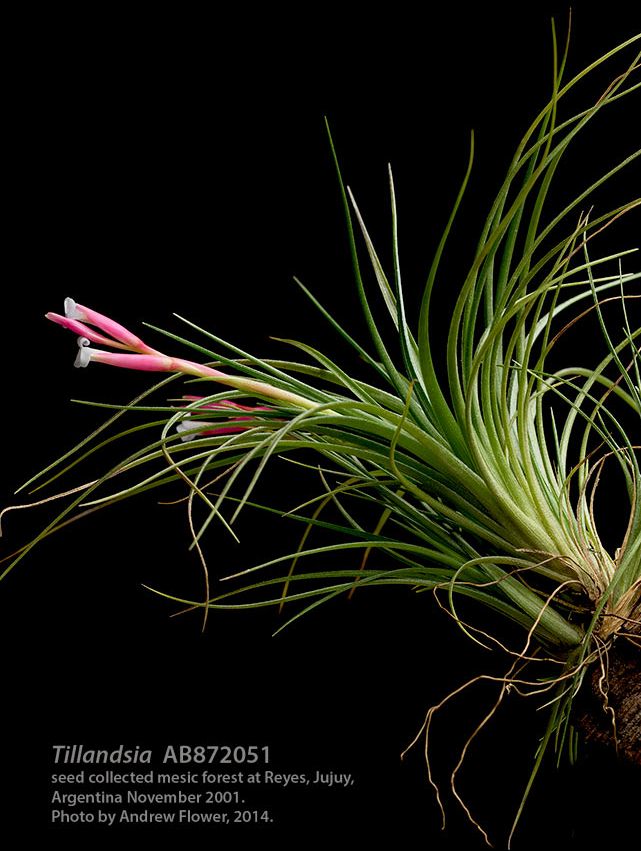
| Andrew Flower 10/18 cf jucunda, Argentina |
Andrew Flower 2015 |
Andrew Flower tenuifolia collected in Reyes |
Andrew Flower ... "Nice one flowering here for the first time - from seed collected in 2001 alongside Highway 9 north of Salta. Early flowering seedlings from this pod looked like Tillandsia jucunda, but they have turned out to be pretty variable and I suspect there is a mixing of T. jucunda and nearby T. ixioides going on here! Or some other species I don't know about...
This tillandsia has a much more compact inflorescence that "normal" T. jucunda, and certainly does not smell anything like jasminum (per the DVD!) - in fact doesn't smell at all so far as I can tell."
Chris Larson ... "Nice photo Andrew. It may just be an example of the theory that it is a natural hybrid – at least I thought I read that somewhere."
Andrew Flower ... "Thanks, you probably did read it somewhere - maybe: "...My own observaton is that T. jucunda Castellanos is a putative hybrid between the sympatric T. ixioides and T. tenuifolia." (Isley, Paul T. III, Tillandsia, Botanical Press, Gardena, California, 1987. p. 180)
Probably is some sort of hybrid swarm, see attached image of another from this seed pod that flowered in 2015. (note different leaf colour - they were photographed in the same natural light situation in the shadehouse.)"
Derek Butcher ... "Which raises further issues. Was Isley talking about the white petalled tenuifolia or the blue. Blue mixed with yellow gives green and we do have a green petalled variety."
Andrew Flower ... "Derek:
1. You would have to ask Mr Isley what he was thinking about - petal colour did not feature in his discussion I referred to.
2. The accompanying picture of T. jucunda on page 180 of his book has yellow petals, and an inflorescence very similar to my AB872087-5575.
3. The seedlings from pods of T. tenuifolia I collected further up the road in Reyes that have flowered to date all have whites flowers. Which of course does not exclude the possibility of a blue flowered T. tenuifolia lurking in NW Argentina.
4. I tend to associate the blue flowered T. tenuifolias over here as originating from our early imports from Brazil."
Ed. ... "See also T. Aussie Gold on this site."
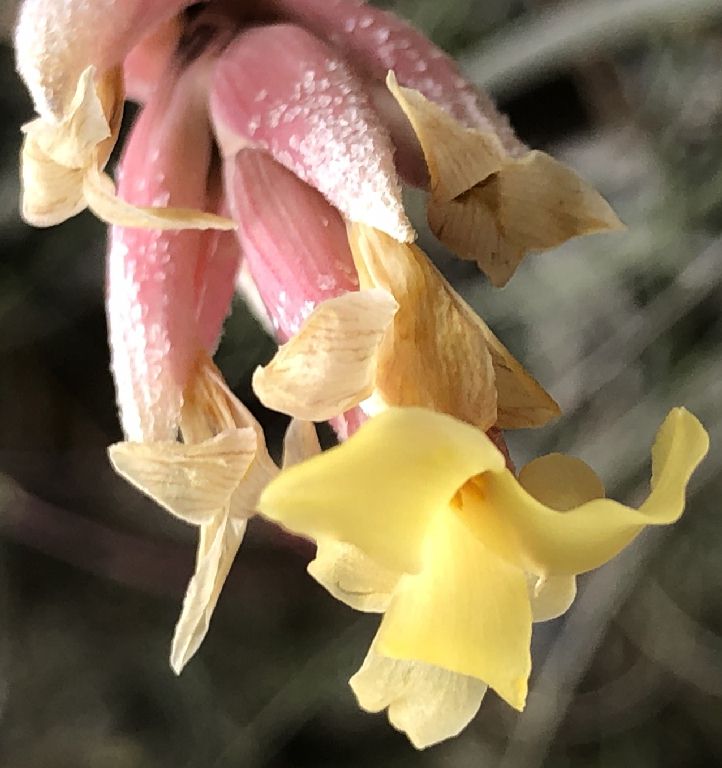
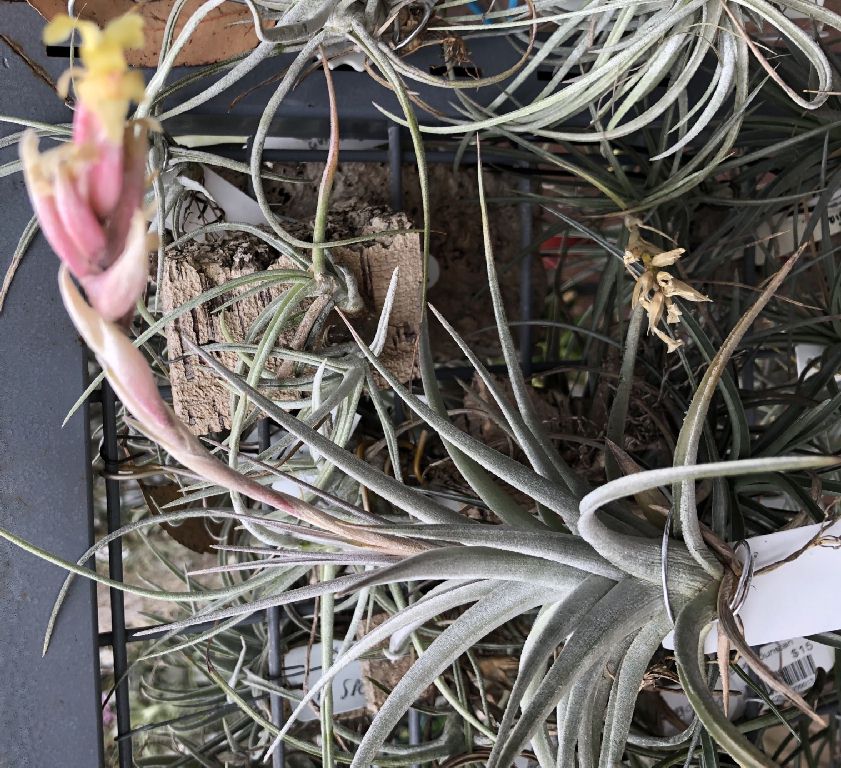
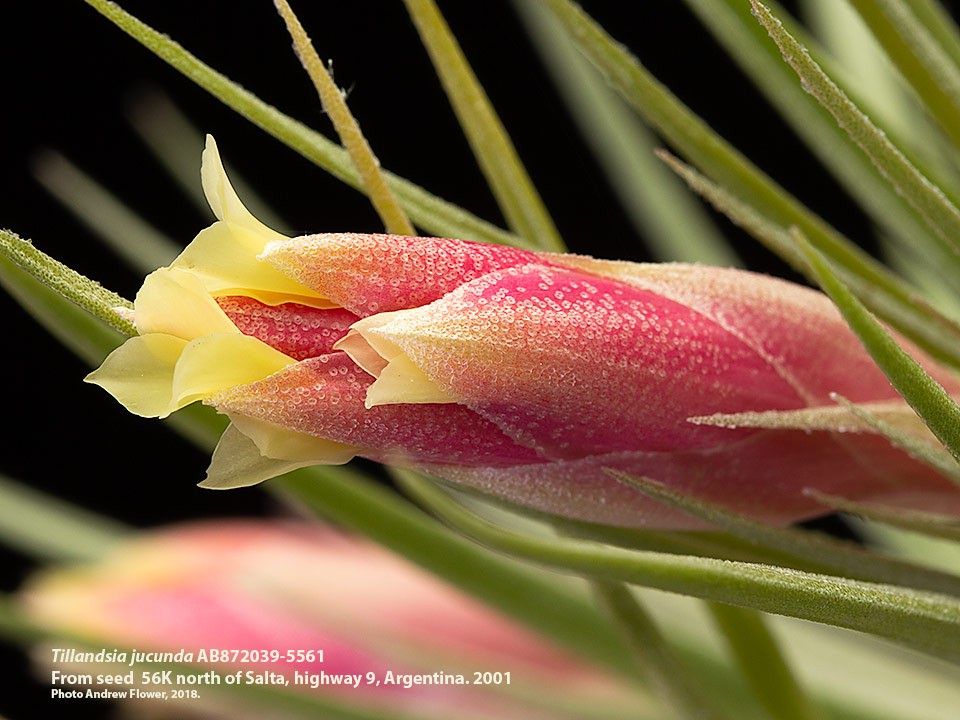
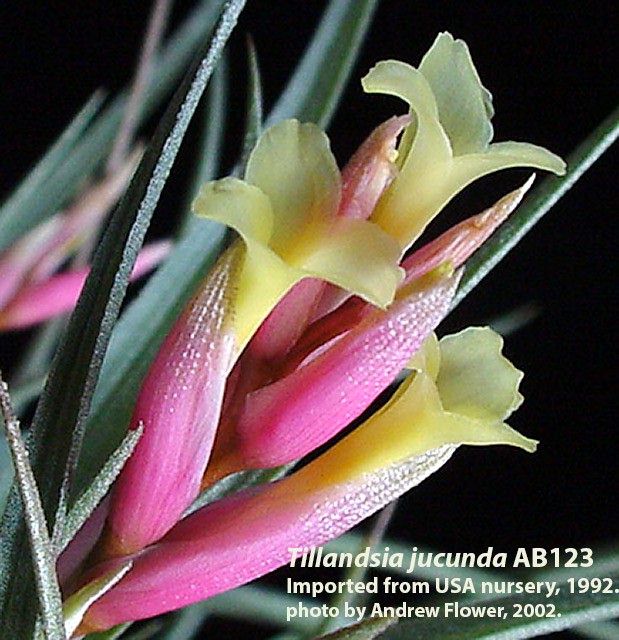
| Dale Dixon 12/19 bought as ixioides |
Andrew Flower 12/19 |
Dale Dixon ... "This one was bought as T. ixioides albeit without provenance information. I’m thinking T. jucunda or maybe T. ‘Aussie Gold’, T. ‘White Star’, T. ‘Holm’s Citrine’. Any other ideas?"
Andrew Flower ... "Looks pretty much like what I think of as an Argentinian T. jucunda - much like picture above that I grew from seed collected near Salta, Argentina.
Having said that, I grew quite a lot of seed collected in that area: many T. ixiodes, many T. jucunda, and very many intermediate between the two!"
Derek Butcher ... "If your plant had cropped up 30 years ago I would have suggested jucunda because of the yellow petals and pink floral bracts. These days, hybrids and seed raised plants abound."
Andrew Flower ... "For Uncle D, who likes to reminisce. Here is a 30-year old Tillandsia jucunda Imported from USA Nursery 1992."
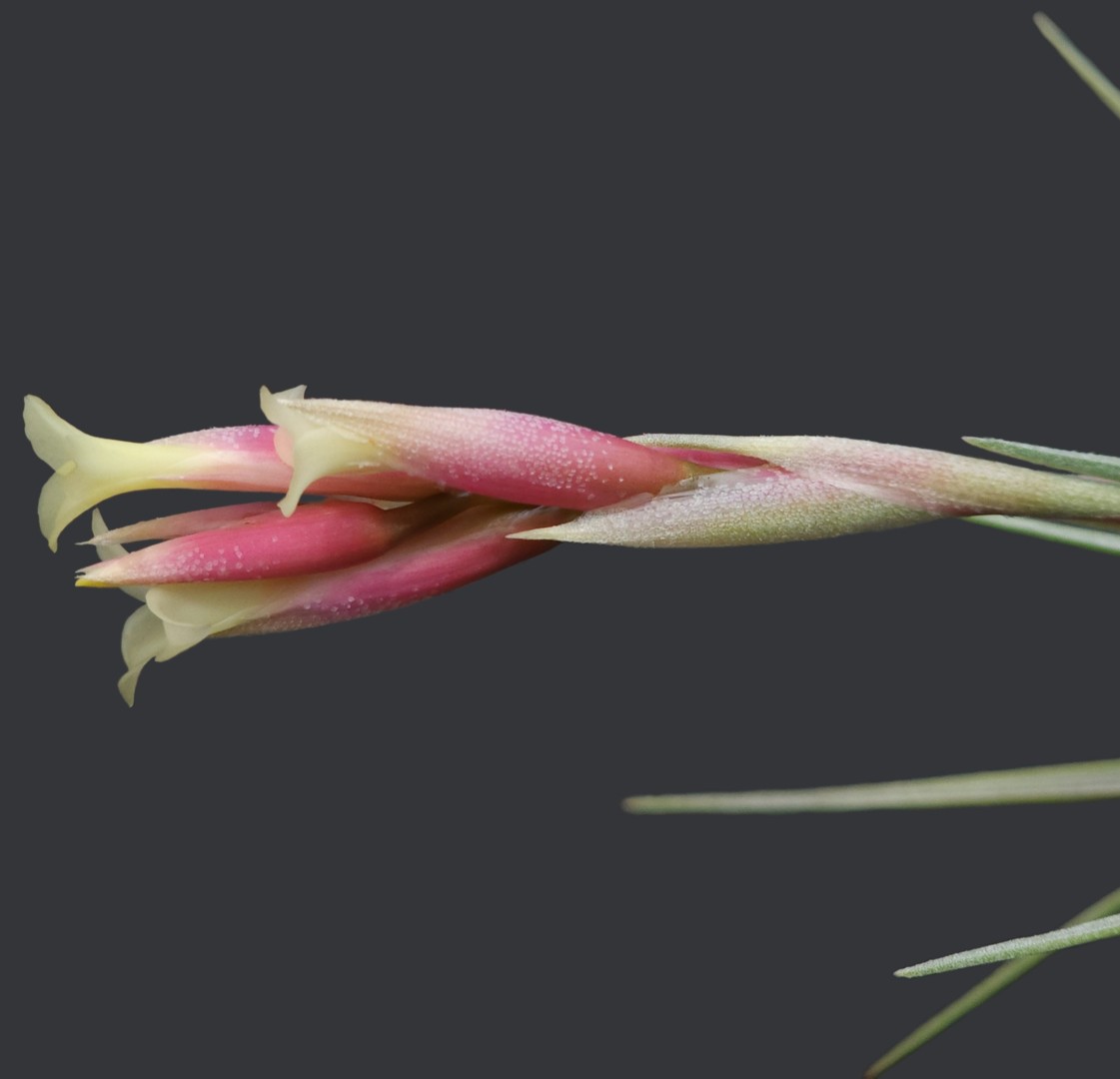
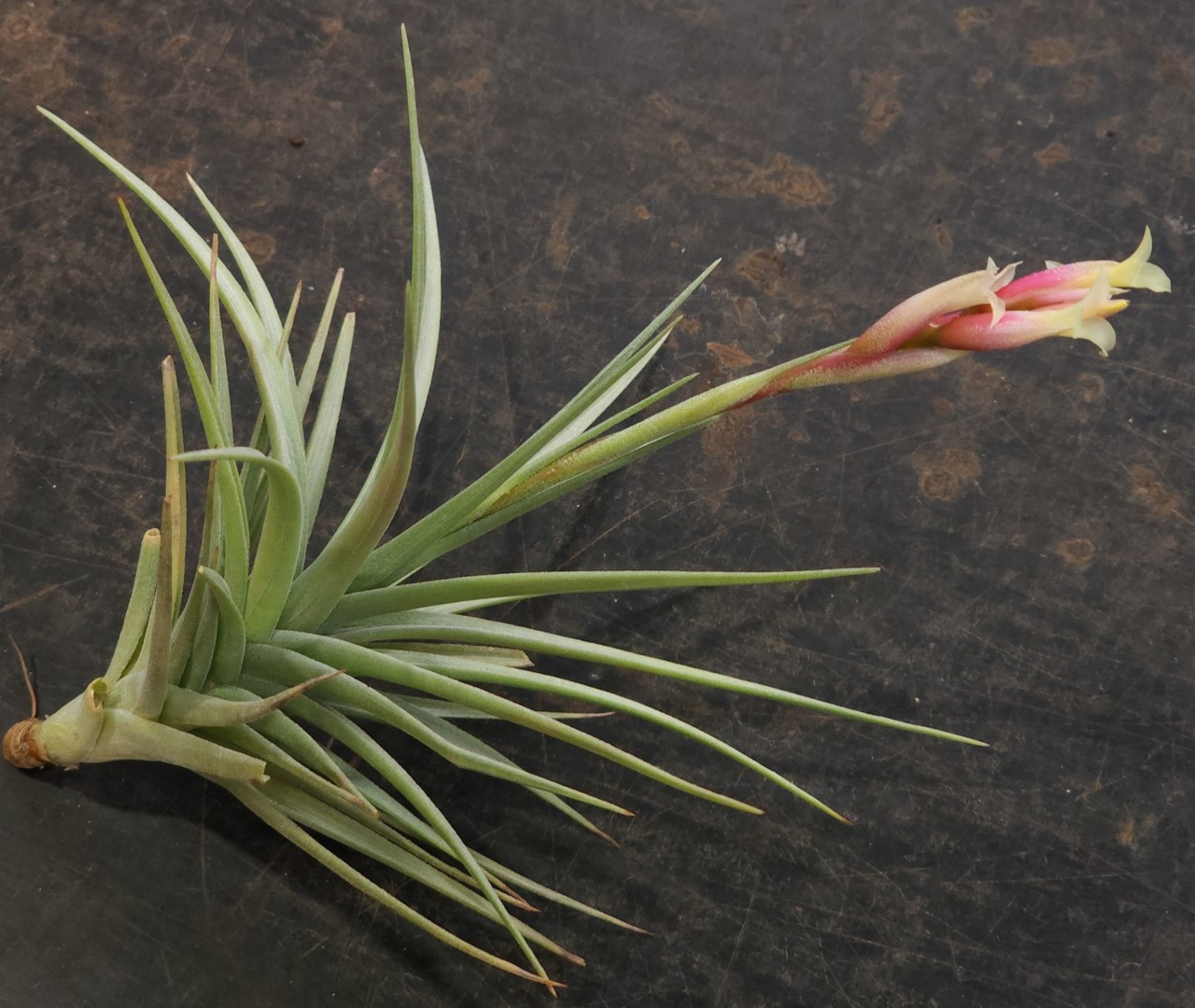
| Chris Larson 02/23. Another new commercial plant. Comes as T. jucunda 'White Star'. In reasonable quantities. Not T. 'White Star'. Probably just a T. jucunda cultivar. |
Ray Clark ... "Hi Chris, dare I say it, your plant does look a lot like the run-of-the-mill jucunda. As you point out, we already have T. 'White Star' and also T. 'Holm's White Star'. Can you see anything unusual or perhaps a variation to warrant a CV name?"
Tillandsia jucunda var. viridiflora
(Note: Originally ixioides var. viridiflora (1980's)
then jucunda var. viridiflora (1990's)
now reclassified as ixioides ssp. viridiflora)
See ixioides page for more images.
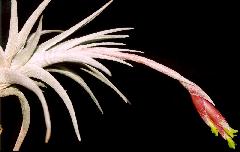
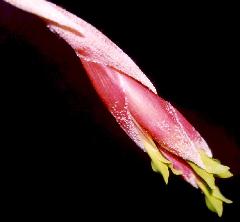
| Ken Woods 08/04 as jucunda v. viridiflora |
Tillandsia jucunda Castellanos, An. Mus. Nac. Hist. Nat. Buenos Aires 36: 56,pl. 1, Bb. 1929.
Desc from S&D p822
Plant caulescent, flowering 10-20 cm high; stem to 8 cm long, simple or branched.
Leaves densely polystichous along the stem, to 15 cm long, covered with appressed cinereous scales;
Sheaths obscure, glabrous at extreme base;
Blades very narrowly triangular, curved and often more or less secund, 5-10 mm wide, involute-subulate, often carinate, thick, rigid.
Scape erect or ascending, slender, glabrous;
Scape-bracts exceeding the internodes but often divergent and exposing the scape, elliptic, foliaceous-laminate or the upper merely apiculate, covered with pale appressed scales.
Inflorescence simple, of about 7 polystichous flowers, to 5 cm long, usually lax toward base.
Floral bracts ovate or lanceolate, acute, to 56 mm long, the lowest exceeding the flowers, thin, roseate, palelepidote toward apex;
Pedicels 1.5 mm long;
Flowers fragrant like jasminum.
Sepals lanceolate, equally subfree, the anterior 13 mm long, the posterior 15 mm long and carinate, roseate, glabrous;
Petals spatulate, acute, 30 mm long, yellow;
Stamens included; fllaments plicate; anthers 3 mm long.
Type. Schreiter 26/2367 (holotype BA, US photo), El Cadillal, Tucuman, Argentina, 15 Sep 1926.
DISTRIBUTION. Epiphytic in woods, 600-900 m alt, northwestern Argentina. ARGENTINA. JUJUY: Santa Barbara to Juntas, 10 Ju11901, Fries 285 (S). SALTA: Sierra de la Candelaria,4 Sep 1929, Venturi 9479 (GH, US). TUCUMAN: Cadillal, Capital, 19 Sep 1920, Schreiter 1361 (GH, LIL); 3 Sep 1922,1369 (GH, LIL, MVM); 10 Aug 1927, Venturi 5490 (MVM); Trancas, Tapia, 10 Oct 1920, Venturi 1000 (GH, US); Rodeo de los Bueyes, Burruyacu, 9 Sep 1922, Venturi 1887 (GH, MVM, US); Alto de Medina, Burruyacu, 8 Sep 1923, Venturi 2491 (GH, US).
Tillandsia jucunda var. viridiflora W. Rauh Bromelienstudien 31 (1979) NOW TREATED AS A SUBSP. OF IXIOIDES (2010)
A typo distinguenda inflorescentiis valde pendulis et floribus omnino viridibus.
Habitat: Bolivia (locus coll. ignotus).
Holotypus : Rausch 54 = hortus botanicus heidelbergensis BGH 31614, herb. inst. bot system. univ. heidelb. (HEID).
Diese neue Varietat, die in der Kultur bereits mehrmals gebluht hat, unterscheidet sich vom gelbbluhenden Typus (var. jucunda) durch die hangenden Infloreszenzen und die rein grunen, nicht gelben Bluten. Sie wurde von dem Kakteensammler W. Rausch, Wien, unter der Nummer 54 (ohne genaue Standortsangabe) in Zentral-Bolivien gesammelt und befindet sich in Kultur im Botanischen Garten der Universitat Heidelberg unter der Nummer 31 614.
Pflanze in Klumpen; Einzelpflanzen stammbildend, bluhend bis 20cm hoch; Blatter zahlreich, spirostich, fast aufrecht, hart; Scheiden undeutlich abgesetzt, rundlich (1.5 x 1cm); Spreiten schmal-lanzettlich, lang zugespitzt, involut, an der Basis 8mm breit, beiderseits dicht grau beschuppt; Infloreszenzschaft hangend, ± 10cm lang, 1.5mm dick (Abb. 6, links); Schaftblatter subfoliat, langer als die Internodien, grau lepidot, die oberen mit rotlicher, lepidoter Spitze; Infloreszenz hangend, einfach, bis 5cm lang, 1.5cm breit, ± 5-blutig; florale Brakteen aufrecht, ± 3cm lang, 1.7cm breit, lanzettlich zugespitzt, dunnhautig, rosafarbig, an der Bais kahl, an der Spitze grau lepidot (Abb. 6, rechts), ecarinat, die Sepalen weit uberragend; diese 16mm lang, lanzettlich zugespitzt, die hinteren carinat, dunn, rosafarbig; Petalen 25mm lang, genagelt, mit ausgebreiteter, stumpfer, 5mm breiter Platte und 3 mm breiten Nagel; Staubblatter und Griffel eingeschlossen.
Somit sind nunmehr die beiden Varietaten bekannt:
var. jucunda: Infloreszenzen ± aufrecht; Bluten gelb (Abb. 5)
var. viridiflora Rauh: Infloreszenzen hangend (Abb. 6); Bluten leuchtend grun
Translated by Butcher
This new variety, that has already flowered in cultivation several times, differs from the yellow flowered Type (var. jucunda), by its hanging inflorescense and the pure green, not yellow flowers. It came from the Cactus collector W. Rausch, Vienna, under the number 54 (without exact location) collected in central Bolivia and is under cultivation in the Botanical Garden of the University of Heidelberg under the number 31 614.
Plant in clumps, single plants with stems, flowering to 20cm high, leaves numerous, spirally arranged, almost erect, hard.
Leaf Sheath indistinct, roundish, (1.5 x 1cm).
Leaf Blade narrow lance like, long acuminate, rolled inwards, 8mm wide at base, both sides dense grey scaled.
Scape hanging, ca. 10cm long, 1.5mm thick.
Scape bracts leaf like, longer than the internodes, grey lepidote, the upper ones with more reddish and more lepidote tip.
Inflorescence hanging, simple, to 5cm long, 1.5cm wide, ca. 5 flowered.
Floral bracts erect, ca. 3cm long, 1.7cm wide, lance like acuminate, thin membranous, pink coloured, at the bottom glabrous, the tips grey lepidote, not keeled, widely exceeds the sepals.
Sepals 16mm long, lance like acuminate, the posterior ones keeled, thin, pink.
Petals 25mm long, pointed, with broad, blunt, 5mm wide platte and 3mm wide point, bright green
Stamens and Style enclosed.
Locality unknown in Bolivia
Type Rausch 54 = BGH31 614 HEID
Consequently, the only known two varieties are:
var. jucunda: Inflorescense +/- erect; flowers yellow ( fig. 5)
var. viridiflora Rauh: Inflorescense hanging ( fig. 6); flowers shiny green
(Has sometimes been unofficially named in the Nursery Trade as T. ixioides var. occidentalis.)
Updated 14/01/24



















